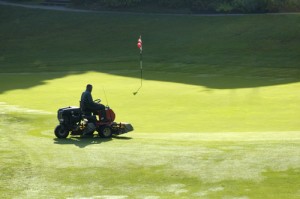
Golf courses need a sturdy, dependable radio that’s just as handy for the groundskeepers trimming the greens as it is for the clubhouse staff serving the steaks.
For years, the simplest choice for golf course managers was the CP200 portable two-way radio (walkie-talkie) from Motorola Solutions. A workhorse of business communications worldwide, the CP200 offered a basic, easy-to-learn set of controls and industrial-strength construction. As the wave of digital technology washed over the radio industry in recent years, Motorola introduced the CP200d, a digital upgrade of the stalwart CP200.
The CP200d is a good match for any business that needs a nothing-fancy, just-get-the-job-done digital radio.
Golf courses and other businesses that have significant indoor and outdoor components to their work are an even better fit.
That’s because the CP200d has a water- and dust-resistance rating of IP54, which means it’s built to survive the occasional splash or downpour and can keep out dust and sand that might foul the electronics of lesser radios. Grounds crews and their supervisors do not need to worry about getting caught out in the middle of an afternoon squall, and restaurant crews need not fear a spilled drink ruining a radio.
Bridging the analog and digital eras
Motorola built the CP200d with the CP200 user in mind: The digital model can communicate in both analog and digital modes, so users of new radios can still talk to people using the old ones.
That allows golf course managers to upgrade at their own pace rather than shoulder the cost of replacing their entire radio network all at once. The CP200d can be purchased new in analog mode and upgraded to digital with a simple software upload.
Golf course managers wondering if they really need digital technology in their radios should keep these points in mind:
- Voice sounds are translated into packets of digital data that can be transmitted over wireless networks, making radios a part of a golf course’s WLAN architecture. Because radios can communicate over the Internet, their range expands dramatically.
- Digital sound quality is clear up to the edge of the radio’s range. It does not get more static-filled as radios move farther and farther out of range.
- The CP200d can use two radios in the bandwidth space required for one analog model, essentially doubling a radio network’s capacity.
- Digital radios are optimized for the human voice and can filter out background sounds like lawnmowers and leaf blowers.
What’s good about the CP200d
For all its new digital technology, the main appeal of the CP200d is its ease of use. There’s one knob on top to change channels and another to turn it on and adjust the volume. There’s one push-to-talk button on the side and two programmable buttons for frequently used functions.
Training is incredibly simple: You teach someone how to turn it on, set the volume, select a channel and press a button to talk to their co-workers. That’s pretty much it.
With the right accessories (noise-blocking headsets for people using loud machinery and hands-free headsets for staff in the clubhouse), it’s a complete one-touch communication tool for golf courses. Key features include:
- 16 channels.
- 1-5 watts of power in VHF, 1-4 watts in UHF.
- Compatible with full MOTOTRBO line of digital radios and communications gear.
- 40% more battery life in digital mode, up to 18 hours on a charge.
Digital technology is where everything’s going. The CP200d proves you don't have to get carried away with it and buy a bunch of features your staff doesn't need; and you can upgrade at whatever pace feels right to you.

MOTOROLA, MOTOROLA SOLUTIONS and the Stylized M Logo are trademarks or registered trademarks of Motorola Trademark Holdings, LLC and are used under license. All other trademarks are the property of their respective owners. ©2015 Motorola Solutions, Inc. All rights reserved.
 Golf courses need a sturdy, dependable radio that’s just as handy for the groundskeepers trimming the greens as it is for the clubhouse staff serving the steaks.
For years, the simplest choice for golf course managers was the CP200 portable two-way radio (walkie-talkie) from Motorola Solutions. A workhorse of business communications worldwide, the CP200 offered a basic, easy-to-learn set of controls and industrial-strength construction. As the wave of digital technology washed over the radio industry in recent years, Motorola introduced the CP200d, a digital upgrade of the stalwart CP200.
The CP200d is a good match for any business that needs a nothing-fancy, just-get-the-job-done digital radio. Golf courses and other businesses that have significant indoor and outdoor components to their work are an even better fit.
That’s because the CP200d has a water- and dust-resistance rating of IP54, which means it’s built to survive the occasional splash or downpour and can keep out dust and sand that might foul the electronics of lesser radios. Grounds crews and their supervisors do not need to worry about getting caught out in the middle of an afternoon squall, and restaurant crews need not fear a spilled drink ruining a radio.
Golf courses need a sturdy, dependable radio that’s just as handy for the groundskeepers trimming the greens as it is for the clubhouse staff serving the steaks.
For years, the simplest choice for golf course managers was the CP200 portable two-way radio (walkie-talkie) from Motorola Solutions. A workhorse of business communications worldwide, the CP200 offered a basic, easy-to-learn set of controls and industrial-strength construction. As the wave of digital technology washed over the radio industry in recent years, Motorola introduced the CP200d, a digital upgrade of the stalwart CP200.
The CP200d is a good match for any business that needs a nothing-fancy, just-get-the-job-done digital radio. Golf courses and other businesses that have significant indoor and outdoor components to their work are an even better fit.
That’s because the CP200d has a water- and dust-resistance rating of IP54, which means it’s built to survive the occasional splash or downpour and can keep out dust and sand that might foul the electronics of lesser radios. Grounds crews and their supervisors do not need to worry about getting caught out in the middle of an afternoon squall, and restaurant crews need not fear a spilled drink ruining a radio.
 MOTOROLA, MOTOROLA SOLUTIONS and the Stylized M Logo are trademarks or registered trademarks of Motorola Trademark Holdings, LLC and are used under license. All other trademarks are the property of their respective owners. ©2015 Motorola Solutions, Inc. All rights reserved.
MOTOROLA, MOTOROLA SOLUTIONS and the Stylized M Logo are trademarks or registered trademarks of Motorola Trademark Holdings, LLC and are used under license. All other trademarks are the property of their respective owners. ©2015 Motorola Solutions, Inc. All rights reserved.




